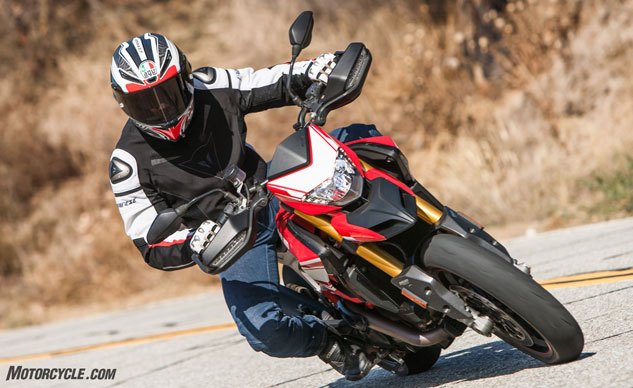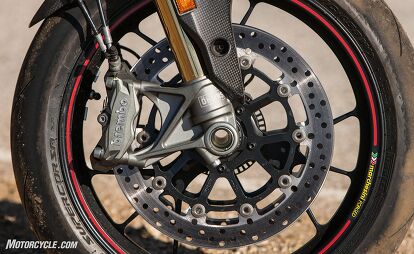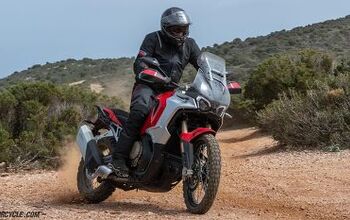2017 Ducati Hypermotard 939 SP Review
A ridiculously fun, seriously expensive street-legal dirtbike
If you’re in the market for a brand new, 100-horsepower, street-legal dirtbike, Ducati’s Hypermotard 939 and Hypermotard 939 SP are pretty much the only game in town (at least, until the updated Aprilia Dorsoduro 900 arrives). Upgraded for 2016 with the 937cc Testastretta 11° L-Twin, compared to last year’s 821cc model, the Hypermotard gains a wee bit more, completely unnecessary, intensity. Like, as if, the outgoing model wasn’t fun enough.
2017 Ducati Hypermotard 939 SP
| Engine | 18.5/20 |
| Suspension/Handling | 14.0/15 |
| Transmission/Clutch | 9.0/10 |
| Brakes | 10.0/10 |
| Instruments/Controls | 4.0/5 |
| Ergonomics/Comfort | 8.0/10 |
| Appearance/Quality | 9.0/10 |
| Desirability | 8.0/10 |
| Value | 7.0/10 |
| Overall Score | 87.5/100 |
It was a couple years ago when we last rode the SP version of Ducati’s Hypermotard, and it was with the company of MV Agusta’s Rivale ( Mega Motard Shootout: 2014 Ducati Hypermotard SP Vs. MV Agusta Rivale). In that shootout the Rivale narrowly defeated the Hypermotard by virtue of its Tre Pistoni engine. “A skilled rider can keep up with his buddy in the tight stuff if you’re on the Hyper and he on the Rivale, but once the MV has a chance to stretch its legs, it’s gone,” said Troy Siahaan in that shootout. So, maybe it’s a good thing Ducati blessed the Hypermotard with a newer, greater-capacity engine.
Without an MV Agusta measuring stick for this review, we’re left grading the Hypermotard 939 SP on its own merits, which are exceptional for the rider willing to commit to a motorcycle that only does one thing well – have fun!
Commitment is also very appropriate wording for the Hyper SP. The new engine upgrade costing an additional $600 more than the 2015 SP model ($15,959 vs $14,995). That’s not a terribly huge MSRP bump, but it moves the Hyper SP closer to $16k, and that seems like a lot of moolah for a glorified dirtbike. Yes, there is a performance increase, but there’s also a weight gain (see dyno chart below).
What that $600 also buys you is a Hyper SP outfitted with an Öhlins fork in place of the Marzocchi unit on the 2014 model. Seat height has been reduced from 35 inches to 34.2 inches, which may be worth a couple hundred bucks alone for vertically challenged folks who shied away from the 2014 Hypermotard due to height concerns. Otherwise, the two models are nearly identical.
The new Hyper SP enjoys a 0.3-inch shorter wheelbase, which theoretically should quicken its canyon-road pace, but, considering the advantages of a more powerful engine, coupled with the disadvantages of increased curb weight, it’s impossible to tell what real-world benefits (or handicaps) the 939 SP owns without a back-to-back comparison. What we do know is the Ducati Hypermotard remains the bike of choice for riders looking for nothing but a good time.
For the common streetbike rider the long-travel suspension (7.3 inches/front, 6.9 inches/rear) of the Hypermotard is going to feel foreign at first. After only a few miles, it becomes apparent that wheelie landings (which happen often) are softened, and an aspect I really enjoy, an extra amount of suspension travel is still available when entering a corner hard on the brakes. Happen across an unforeseen pothole and there’s always enough fork travel to absorb a road encumbrance, whereas street-specific sportbikes and their ilk will have used up most all of their travel with nothing more to give but a harsh bottoming-out when stumbling across such a hazard.
Also unfamiliar to the average street rider will be the Hyper’s seating position, which is very upright and dirt-able, with a very narrow seat and seat/tank juncture, yet still comfortable. Together with the wide handlebars the Hypermotard is fun to flick around in town or in the country, possibly even up a dirt road or down a flight of stairs. When compared to the Rivale, the old Hypermotard exhibited more lethargy when it came to quick transitioning, but by itself the Hypermotard gets from one corner to the next in what seems like hyper fashion.
Like most of Ducati’s higher-end wares, the Hypermotard is outfitted with an array of adjustable electronics. There are three ride modes: Wet, Sport, Race. Each of these come preset for ABS, TC and engine output, but you can also adjust them to personal preferences. When it comes to the Hypermotard’s engine performance make no mistake, it’s race bred. Riding at anything less than 100% is akin to making a thoroughbred dance dressage – it’ll do it but it’s silly.
Engine output can be dialed between Low, Medium, High. When riding aggressively either High or Medium is enjoyable because the snap out of corners is ferocious. Both provide progressive delivery of the engine’s full power, with Medium coming on in more mild fashion. Around town, or when lane splitting through heavy LA traffic I found those two settings to be a little abrupt when smoothness is most warranted. The Low setting dials back engine horsepower to a claimed 75 hp, and further smooths the delivery. I found myself switching to this mode in the two scenarios mentioned above, or when I was getting tired.
2017 Ducati Hypermotard 939 SP
+ Highs
- Fun, like motorcycling should be
- Lower seat height
- Öhlins fork
– Sighs
- There are many more versatile bikes you can buy for $16k
- Got heavier
- No real performance gain
If the Hypermotard 939 SP gets your heart pounding but the $16k price is hard to swallow, the standard model Hyper, at $12,695, will save you $3,300, and it’s largely the same bike, only wheels and suspension components separating them. Or, for a more versatile Hyper that splits the difference, the Hyperstrada 939, at $14,295, might provide a more viable option. The strada version of the Hypers comes outfitted with semi-rigid saddlebags, a touring windshield, touring seat, centerstand, larger fenders, and a engine guard.
Regardless which Hyper model you choose, good times are sure to result. There just aren’t many other motorcycles like it, and the fun factor for any of the three is off the charts. And while we can’t say the new 937cc engine is hugely beneficial over last year’s 821, a few more ponies and foot-pounds never hurt. For more information check out Ducati.com.
2017 Ducati Hypermotard 939 SP Specifications | |
|---|---|
| MSRP | $15,595 |
| Horsepower | 101.2 hp @ 8,700 rpm |
| Torque | 67.3 lb.-ft. @ 7,200 rpm |
| Engine Capacity | 937cc |
| Engine Type | Testastretta 11°, L-Twin cylinder, 4 valve per cylinder, Desmodromic, liquid cooled, magnesium valve covers |
| Bore x Stroke | 94 x 67,5 mm |
| Compression | 13.1:1 |
| Fuel System | Magneti Marelli electronic fuel injection system |
| Transmission | 6-speed |
| Clutch | Slipper and self-servo wet multiplate clutch mechanically operated |
| Final Drive | Chain |
| Frame | Tubular steel trellis |
| Front Suspension | Öhlins fully adjustable 48mm fork |
| Rear Suspension | Fully adjustable Öhlins monoshock. Aluminum single-sided swingarm |
| Front Brakes | Dual 320mm semi-floating discs, radially mounted Brembo monobloc calipers, 4-piston 2-pad, radial pump with adjustable lever, with Bosch ABS as standard |
| Rear Brakes | Single 245mm disc, 2-piston caliper, with Bosch ABS as standard |
| Front Tire | 120/70-17 |
| Rear Tire | 180/55-17 |
| Seat Height | 34.2 inches |
| Wheelbase | 59.0 inches |
| Rake/Trail | 25.5°/4.1 inches |
| Curb Weight | 448 pounds |
| Fuel Capacity | 4.2 gal. |
| Electronics | Riding Modes, Power Modes, Ducati Safety Pack (ABS + DTC), RbW. Marchesini forged rims, tapered aluminum handlebars, carbon fiber components: front mudguard, cam belt covers. Ready for anti-theft system, heated grips, sat-nav |
| Warranty | 24 months unlimited mileage |
A former Motorcycle.com staffer who has gone on to greener pastures, Tom Roderick still can't get the motorcycle bug out of his system. And honestly, we still miss having him around. Tom is now a regular freelance writer and tester for Motorcycle.com when his schedule allows, and his experience, riding ability, writing talent, and quick wit are still a joy to have – even if we don't get to experience it as much as we used to.
More by Tom Roderick


















































Comments
Join the conversation
Yeah for that money I'd get the new Tuono factory. Now with cruise control and full color tft!
Neat bike, however give me a Tuono and I'm good!